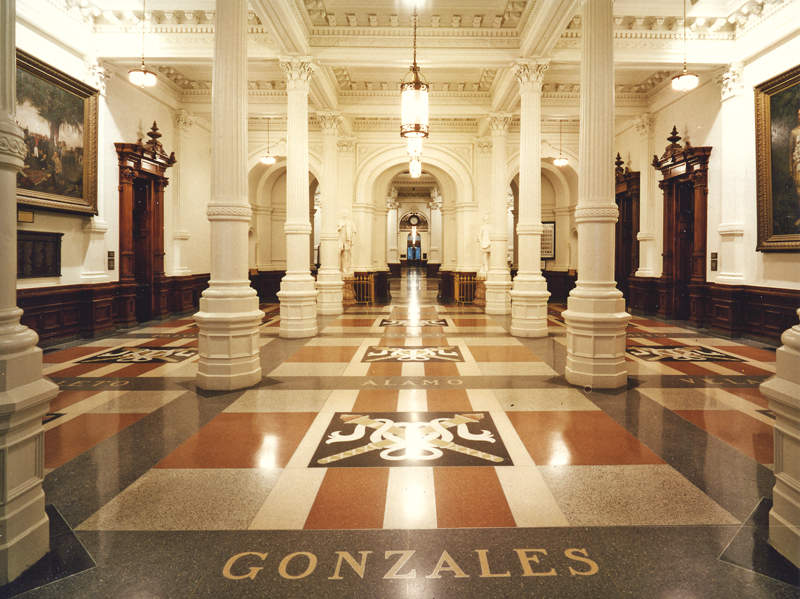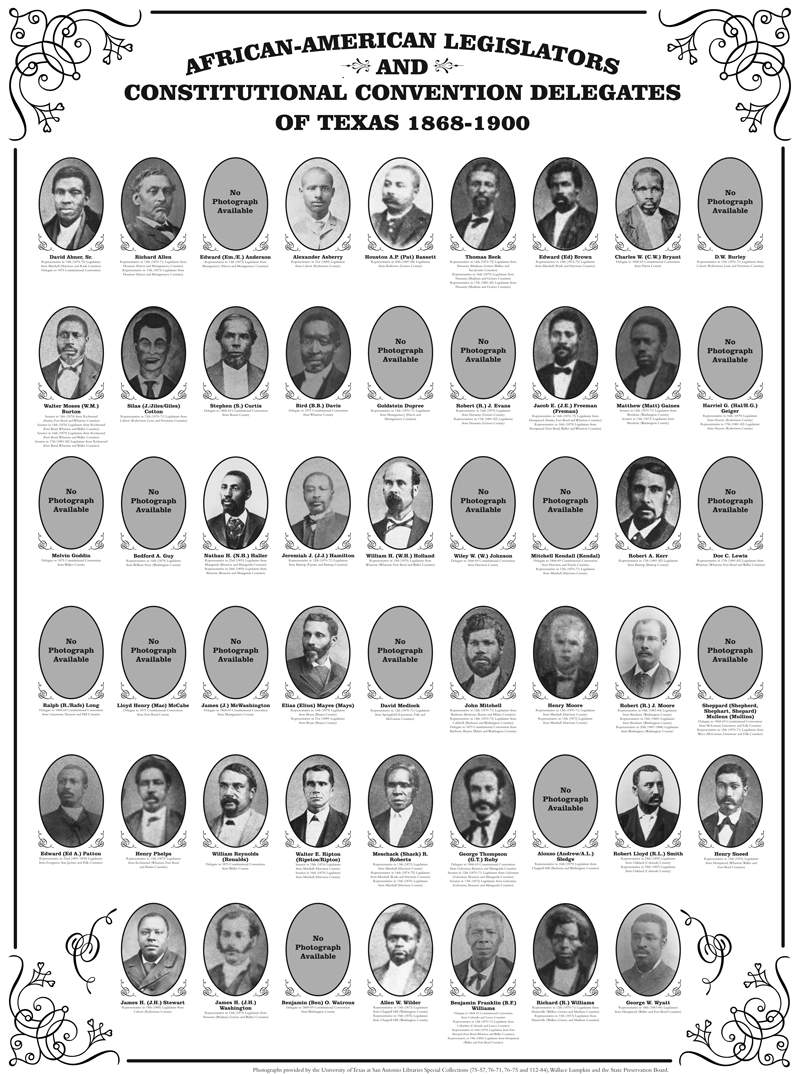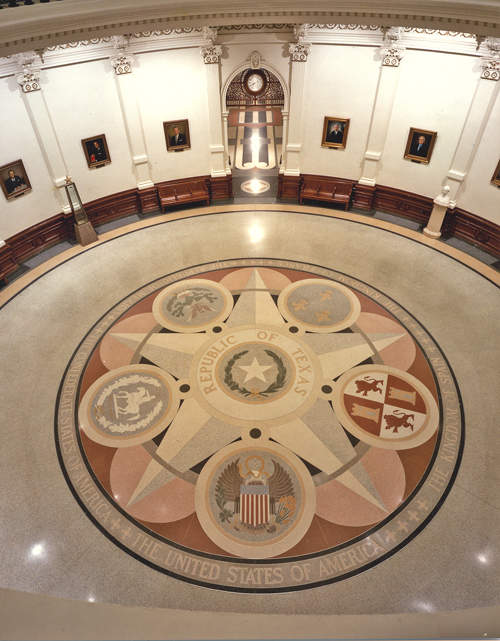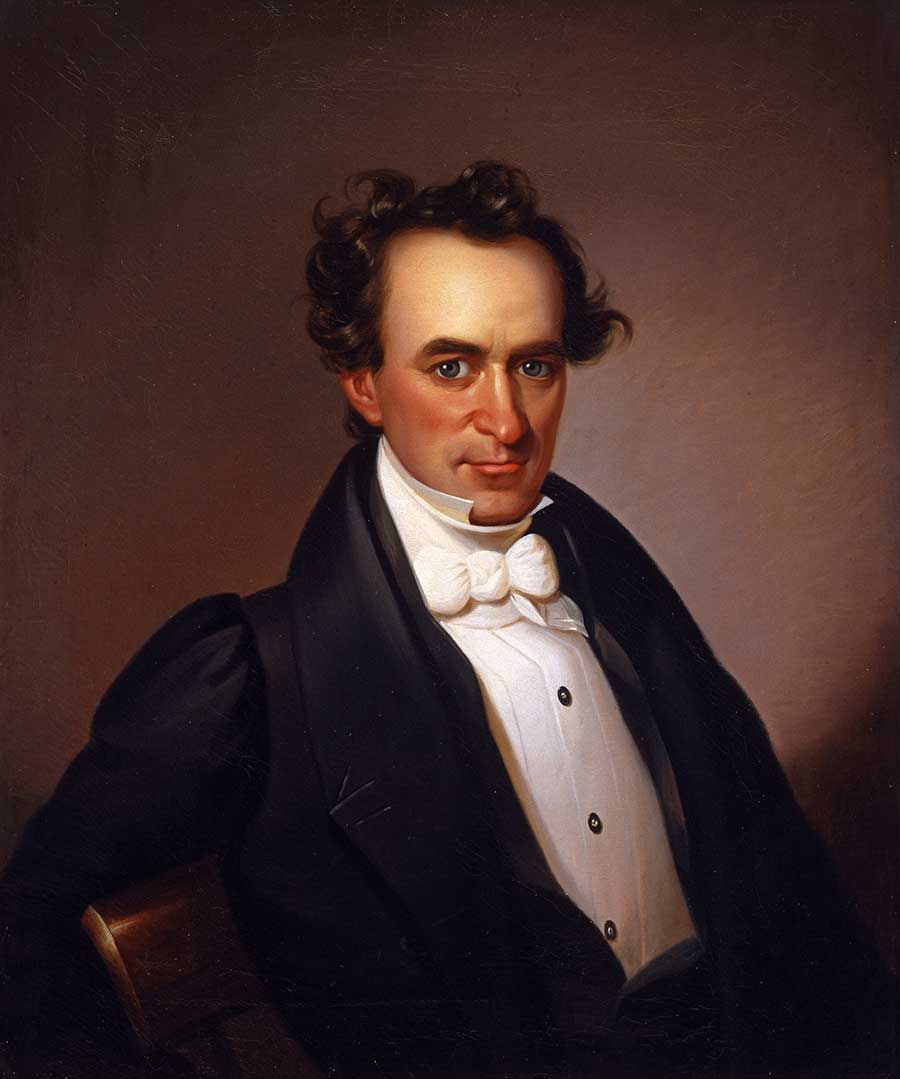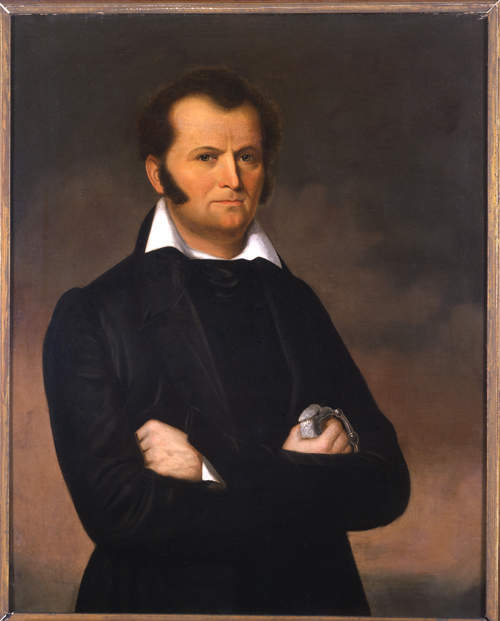Capitol Art
There's more to the Texas Capitol than the legislative process.
Thousands of visitors come to the Capitol every year to witness history and government in action, but there is much more to marvel at throughout the building and the grounds.
From the ornate doorknobs and chandeliers to the works of art commemorating Texas history, the story of Texas is around every corner and on every wall, ceiling, and floor of the Capitol building.
The South Foyer
Two large paintings greet you as you enter the south foyer of the Capitol: Davy Crockett and Surrender of Santa Anna by William H. Huddle (1847-1992). Davy Crockett presents the popular frontiersman in his fabled garb, coonskin cap included. Surrender of Santa Anna gives Huddle's interpretation of the moment when the Mexican general surrendered to General Sam Houston. It is widely believed that Santa Anna was captured after escaping into the woods following the Battle of San Jacinto. Santa Anna appears disguised in a private's uniform in Huddle's painting as Sam Houston, reclining on a blanket after being wounded in battle, negotiates the armistice with the defeated general.
Flanking the entryway to the first floor rotunda are statues of Stephen F. Austin and Sam Houston. Sculpted by German-born artist Elisabet Ney, the statues depict two of Texas' most significant heroes. Stephen F. Austin, popularly regarded as the "Father of Texas," established the state's first colonies when Mexico issued land grants to Anglo-American settlers to bolster growth in its northern regions. Sam Houston, a leader throughout the Texas Revolution, also served as the first president of the Republic of Texas and served Texas as a state as both governeor and U.S. senator.
Texas has been shaped by the legislative accomplishments of many African-American men and women. The photo composite of the African-American Legislators and Constitutional Convention Delegates , mounted in the east alcove just above the entrance to the Rotunda, features thirty-five of the fifty-two Texas citizens who played a part in governing Texas. The composite features State Senator George T. Ruby (1869-73), State Senator Matthew Gaines (1870-74), Representative Edward Patton (1890-1894), and Representative William H. Holland (1876-1886) among many others. No African Americans were elected to the state legislature from 1899 until 1966, when Barbara Jordan was elected to the state Senate and Curtis M. Graves was elected to the House.
Millions of tourists have walked over a magnificent piece of art right under their feet in the south foyer. Installed in 1936 as a replacement for the original clay tile flooring, the terrazzo floor is a celebration of Texas' centennial, marking the 100-year anniversary of the state's independence from Mexico. Through the blend of colored marble chips and a wet binding similar to concrete, the terrazzo floor commemorates the twelve important Texas battles fought during the Texas Revolution, the Mexican-American War, and the Civil War.
Capitol Rotunda
From the floor to the star at the peak, the Capitol rotunda stands about 218 feet. A late addition to the original 1888 Capitol, the rotunda and its spiralling domed ceiling are now one of the most photographed architectural features of the building.
The first floor of the rotunda features the Great Seal of the Republic of Texas. The seals of the six sovereign nations that governed all or parts of Texas before its independence surround the Republic's symbol.
Portraits of Texas governors line the walls of the first floor and spiral up all the way to the fourth floor where you'll find the first presidents of the Republic. Start from the top or the bottom, by walking the floors around the rotunda you'll take a virtual trip through the history of Texas leadership.
The Senate Chamber
Treasured works of art hang throughout the Chamber on the second floor of the Capitol.
At the entrance to the Senate Chamber, two large oil paintings, Dawn at the Alamo and The Battle of San Jacinto, interpret two of the most important battles of the Texas Revolution. Painted by Irish-born Texas artist Henry Arthur McArdle, these outstanding works of art are McArdle's dramatic interpretations of the events, rather than historically accurate representations.
The many portraits that line the walls of the Chambers depict key figures in Texas history. A mid-nineteenth century painting of Stephen F. Austin by an unknown artist takes pride of place in the chamber. Austin is flanked by Jefferson Davis and John H. Reagan. Davis, the president of the defeated Confederates States of America, was a major proponent of the annexation of Texas to the United States in 1844 while serving as a Senator from Mississippi. Reagan served as a delegate to the Texas Constitutional Convention that framed the Constitution of 1876. He went on to serve in the U.S. Senate in 1887 and headed the Railroad Commission in 1891.
Other paintings in the Senate Chamber honor various Texas leaders: A.M Aikin, forty-year State Senator and "Father of Education"; Lorenzo de Zavala, a Texas revolutionary and future vice-president of the Republic of Texas; Albert Sidney Johnston, Secretary of War for the Republic of Texas and renowned Civil War general; William Physick Zuber, a significant contributor to Texas historical writing; David Culberson, a member of the Texas Legislature from 1859-1860, 1873-1875, and U.S. Congressman from 1875-1897; Joseph Weldon Bailey, veteran member of both the U.S. House of Representatives and the U.S. Senate; Thomas Jefferson Rusk, one of the first two U.S. Senators from the State of Texas (the other being Sam Houston); Robert Williamson, who served in the fifth and ninth Congresses of the Republic of Texas, and Texas Senator for the first two sessions after Texas's annexation; Mirabeau B. Lamar, first vice president and second president of the Republic of Texas; Alfonso Steele, the oldest Texas survivor of the Battle of San Jacinto; Reuben Potter, an advocate for Texas independence and revered historian; Barbara Jordan, the first African-American woman elected to the Texas Senate in 1966, elected as President Pro Tempore in 1972, and the first African American woman elected to the U.S. House of Representatives in 1973, where she served two terms; Barnett Gibbs, Texas Senator from 1882-1883 and Lieutenant Governor from 1884-1889; President Lyndon Baines Johnson, the 36th President of the United States and the first Texan to serve in that position; Joanna Troutman, often called the "Betsy Ross of Texas" and credited with creating an early Texas Lone Star flag for volunteers in support of Texas independence; and Henry B. Gonzalez, the first Mexican American to serve in the Texas Senate from 1957 to 1961 when he was elected to the U.S. House of Representatives, serving until 1997.
House of Representatives
Located in the west wing of the Capitol, the House of Representatives also features works of art of great importance to preserving the legacy of Texas. The collection has been in place in the House Chambers for over twenty years, with the exception of the four composites which are updated every two years. Two paintings of Stephen F. Austin hang on each end of the House. The first, The Settlement of Austin's Colony, was painted by H.A. McArdle, the painter of the two battle scenes in the Senate Chamber. The second is a duplicate of the Oak Tree portrait of Austin painted in Mexico around 1834 by a Chicago artist.
Like the portraits in the Senate, the art in the House features many notable Texans and figures in Texas history. The portraits include James S. Hogg, the first native Texan to serve as governor, serving from 1891 until 1895; a portrait of Sam Houston entitled The Raven; "Mr. Sam" Sam Rayburn, who served in the Texas House from 1906 until 1912, serving as speaker in 1911 when he was elected to serve in the U.S. House for nearly fifty years serving as Minority and Majority Leader, as well as Speaker of the House; Joint Commander of the Alamo James Bowie; Audie Murphy, born in Kingston, just outside of Dallas, the most decorated American soldier of World War II; Irish-born Richard Dowling, a Confederate soldier in Texas and important figure in the Civil War; Edward Burleson, an early Texas settler and colonel of the Texas army in the Battle of San Jacinto who was elected vice president of the Republic of Texas in 1841; John Nance Garner, the first Speaker of the U.S. House from Texas and vice president of the United States (1933-41); Sterling C. Robertson, who signed the Texas Declaration of Independence and served in the First and Second Congresses of the Republic of Texas; Roger Q. Mills, an early settler and member of the Texas House, as well as the U.S. House and U.S. Senate in the late 1800s; Governor Francis R. Lubbock, elected Lt. Governor in 1857 and Governor in 1861, serving Texas in many capacities before and after the Civil War; and Alexander W. Terrell, who served in the Texas House and Senate for sixteen years.
Although the Capitol may be best known as the seat of Texas government, the building also holds many treasures that tell the stories of Texas's history.
